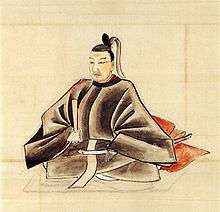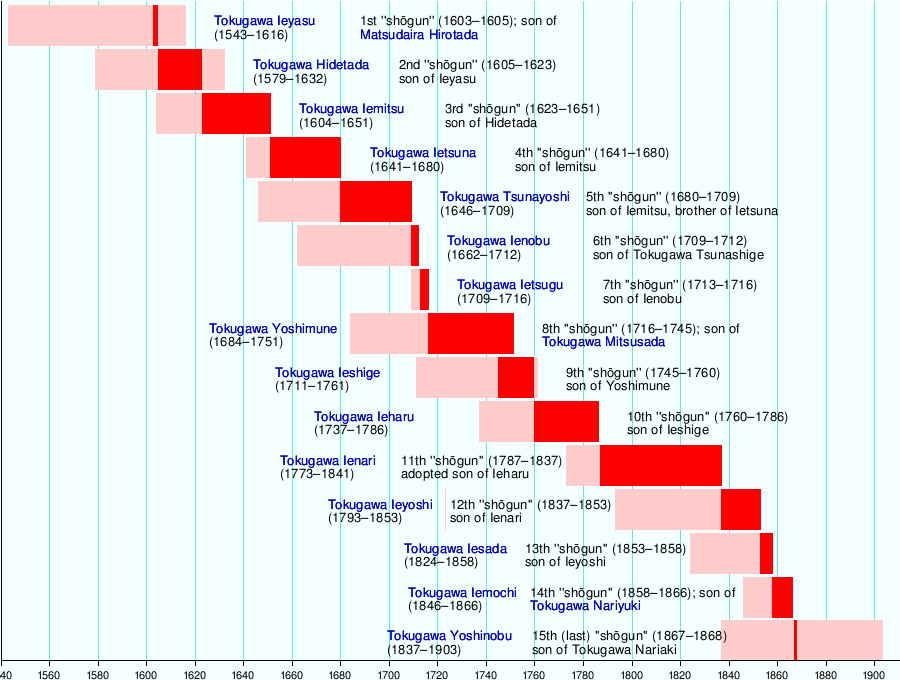Tokugawa Ieharu
Tokugawa Ieharu (徳川家治) (June 20, 1737 – September 17, 1786) was the tenth shōgun of the Tokugawa shogunate of Japan, who held office from 1760 to 1786.
Tokugawa Ieharu | |
|---|---|
 | |
| Shōgun | |
| In office 1760–1786 | |
| Monarch | |
| Preceded by | Tokugawa Ieshige |
| Succeeded by | Tokugawa Ienari |
| Personal details | |
| Born | June 20, 1737 |
| Died | September 17, 1786 (aged 49) |
His childhood name was Takechiyo (竹千代).
Ieharu died in 1786 and given the Buddhist name Shunmyoin and buried at Kan'ei-ji.
Family
- Father: Tokugawa Ieshige
- Mother: Oko no Kata (d. 1728) later Shinshin'in
- Wife: Iso no Miya Tomoko (1738–1771)
- Concubines:
- Omiyo no Kata
- Ochiho no Kata (1737–1791) later Renkoin
- Oshina no Kata (d. 1778) later Yoren-in
- Child:
- Chiyohime (1756–1757) by Tomoko
- Manjuhime (1761–1773) (born by Tomoko but after she died adopted by Ieharu's concubine, Omaki no Kata)
- Tokugawa Takechiyo later Tokugawa Iemoto (1762–1779) born by Ochiho no Kata
- Tokugawa Teijiro (1762–1763) born by Oshina no Kata
- Adopted:
- Tokugawa Ienari
- Tanehime (1765–1794), daughter of Tokugawa Munetake and married Tokugawa Harutomi of Kishū Domain
Events of the Ieharu's bakufu
- Tenmei gannen (天明元年) or Tenmei 1 (1781): The new era name of Tenmei (meaning "Dawn") was created to mark the enthronement of Emperor Kōkaku. The previous era ended and the new one commenced in An'ei 11, on the 2nd day of the 4th month. According to Nihon Ōdai Ichiran, Ieharu was appointed Udaijin (Minister of the Right) of the Emperor's Kugyō, which was quite rare and considered a great favour.
- Tenmei 2 (1782): Great Tenmei Famine begins.
- Tenmei 2 (1782): An analysis of silver currency in China and Japan "Sin sen sen pou (Sin tchuan phou)" was presented to the emperor by Kutsuki Masatsuna (1750–1802), also known as Kutsuki Oki-no kami Minamoto-no Masatsuna, hereditary daimyō of Oki and Ōmi with holdings in Tanba and Fukuchiyama -- related note at Tenmei 7 below.[1]
- Tenmei 3 (1783): Mount Asama (浅間山, Asama-yama) erupted in Shinano, one of the old provinces of Japan. Japanologist Isaac Titsingh's published account of the Asama-yama eruption was the first of its kind in the West (1820).[2] The volcano's devastation makes the Great Tenmei Famine even worse.
- Tenmei 4 (1784): Country-wide celebrations in honor of Kūkai (also known as Kōbō-Daishi, founder of Shingon Buddhism) who died 950 years earlier.[1]
- Tenmei 4 (1784): The son of the shōgun's chief counselor was assassinated inside Edo Castle. The comparatively young wakadoshiyori, Tanuma Yamashiro-no-kami Okitomo, was the son of the senior wakadoshiyori Tanuma Tonomo-no-kami Okitsugu. The younger Tanuma was killed in front of his father as both were returning to their norimono after a meeting of the Counselors of State had broken up. The involvement of senior figures in the bakufu was suspected; however, none but the lone assassin himself, Sano Masakoto, was punished. The result was that Tanuma-initiated, liberalizing reforms within the bakufu and relaxation the strictures of sakoku were blocked.[3]
- Tenmei 6, on the 8th day of the 9th month (September 17, 1786): Death of Tokugawa Ieharu. He is buried in Edo.[1]
- Tenmei 7 (1787): Kutsuki Masatsuna published Seiyō senpu (Notes on Western Coinage), with plates showing European and colonial currency – related note at Tenmei 2 above.[4] – see online image of 2 adjacent pages from library collection of Kyoto University of Foreign Studies and Kyoto Junior College of Foreign Languages
Eras of Ieharu's bakufu
The years in which Ieharu was shōgun are more specifically identified by more than one era name or nengō.[1]
Ancestry
| Ancestors of Tokugawa Ieharu | ||||||||||||||||||||||||||||||||||||||||||||||||||||||||||||||||||||||||||||||||||||||||||||||||||||||||||||||||||||||||||||||||||||||||||||||||||||||||||||||||||||||||||||||||||||||||||||||||||||||||||||||||||||||||||||||||||||||||||||||||||||||||||||||||||||||||||||||||||||||||||||||||||||||||||||||||||||||||||||||||||||||||||||||||||||||||||||||||||||||||||||||||||||||||||||||||||||||||||||||||||||||||||||||||||||||||||||||||||||||||||||||||||||||||||||||||||||||||||||||||||||||||||||||||||||||||||||||||||||||||||||||||||||||||||||||||||||||||||||||||||||||||||||||||
|---|---|---|---|---|---|---|---|---|---|---|---|---|---|---|---|---|---|---|---|---|---|---|---|---|---|---|---|---|---|---|---|---|---|---|---|---|---|---|---|---|---|---|---|---|---|---|---|---|---|---|---|---|---|---|---|---|---|---|---|---|---|---|---|---|---|---|---|---|---|---|---|---|---|---|---|---|---|---|---|---|---|---|---|---|---|---|---|---|---|---|---|---|---|---|---|---|---|---|---|---|---|---|---|---|---|---|---|---|---|---|---|---|---|---|---|---|---|---|---|---|---|---|---|---|---|---|---|---|---|---|---|---|---|---|---|---|---|---|---|---|---|---|---|---|---|---|---|---|---|---|---|---|---|---|---|---|---|---|---|---|---|---|---|---|---|---|---|---|---|---|---|---|---|---|---|---|---|---|---|---|---|---|---|---|---|---|---|---|---|---|---|---|---|---|---|---|---|---|---|---|---|---|---|---|---|---|---|---|---|---|---|---|---|---|---|---|---|---|---|---|---|---|---|---|---|---|---|---|---|---|---|---|---|---|---|---|---|---|---|---|---|---|---|---|---|---|---|---|---|---|---|---|---|---|---|---|---|---|---|---|---|---|---|---|---|---|---|---|---|---|---|---|---|---|---|---|---|---|---|---|---|---|---|---|---|---|---|---|---|---|---|---|---|---|---|---|---|---|---|---|---|---|---|---|---|---|---|---|---|---|---|---|---|---|---|---|---|---|---|---|---|---|---|---|---|---|---|---|---|---|---|---|---|---|---|---|---|---|---|---|---|---|---|---|---|---|---|---|---|---|---|---|---|---|---|---|---|---|---|---|---|---|---|---|---|---|---|---|---|---|---|---|---|---|---|---|---|---|---|---|---|---|---|---|---|---|---|---|---|---|---|---|---|---|---|---|---|---|---|---|---|---|---|---|---|---|---|---|---|---|---|---|---|---|---|---|---|---|---|---|---|---|---|---|---|---|---|---|---|---|---|---|---|---|---|---|---|---|---|---|---|---|---|---|---|---|---|---|---|---|---|---|---|---|---|---|---|---|---|---|---|---|---|---|---|---|---|---|---|---|---|---|---|---|---|---|---|---|---|---|---|---|---|---|---|---|---|---|---|---|---|---|---|---|---|---|---|---|---|---|---|---|---|---|---|---|---|---|---|---|---|---|---|---|---|---|---|---|---|---|---|---|---|---|---|---|---|---|---|---|---|---|---|---|---|---|---|---|---|---|---|---|---|---|---|---|---|---|---|---|---|---|---|---|---|---|---|---|---|---|---|---|---|---|---|---|---|---|---|---|---|---|---|---|---|---|
| ||||||||||||||||||||||||||||||||||||||||||||||||||||||||||||||||||||||||||||||||||||||||||||||||||||||||||||||||||||||||||||||||||||||||||||||||||||||||||||||||||||||||||||||||||||||||||||||||||||||||||||||||||||||||||||||||||||||||||||||||||||||||||||||||||||||||||||||||||||||||||||||||||||||||||||||||||||||||||||||||||||||||||||||||||||||||||||||||||||||||||||||||||||||||||||||||||||||||||||||||||||||||||||||||||||||||||||||||||||||||||||||||||||||||||||||||||||||||||||||||||||||||||||||||||||||||||||||||||||||||||||||||||||||||||||||||||||||||||||||||||||||||||||||||
Notes
- Titsingh, Isaac. (1834). Annales des empereurs du japon, p. 420
- Screech, T. (2006), Secret Memoirs of the Shoguns: Isaac Titsingh and Japan, 1779–1822, pp. 146–148.
- Screech, pp. 148–151, 163–170, 248.
- Screech, T. (2000). Shogun's Painted Culture: Fear and Creativity in the Japanese States, 1760–1829, pp. 123, 125.
- "Genealogy". Reichsarchiv (in Japanese). Retrieved 5 July 2018.
gollark: Okay, that was a false negative.
gollark: Never mind, false positive.
gollark: Oh hey, the logs say Lemmmy commited blasphemy.
gollark: Hi.
gollark: My furnace machine ran out of storage within a few days and also spilled items everywhere.
References
- Hall, John Whitney. (1955) Tanuma Okitsugu: Forerunner of Modern Japan. Cambridge: Harvard University Press.
- Screech, Timon. (2000). Shogun's Painted Culture: Fear and Creativity in the Japanese States, 1760–1829. London: Reaktion Books. ISBN 978-1-86189-064-1
- Screech, Timon. (2006). Secret Memoirs of the Shoguns: Isaac Titsingh and Japan, 1779–1822. London: RoutledgeCurzon. ISBN 0-7007-1720-X
- Titsingh, Isaac. (1822). Illustrations of Japan. London: Ackerman.
- Titsingh, Isaac. (1834). [Siyun-sai Rin-siyo/Hayashi Gahō, 1652], Nipon o daï itsi ran; ou, Annales des empereurs du Japon. Paris: Oriental Translation Fund of Great Britain and Ireland.
- Totman, Conrad. (1967). Politics in the Tokugawa bakufu, 1600–1843. Cambridge: Harvard University Press.
External links
| Wikimedia Commons has media related to Tokugawa Ieharu. |
| Military offices | ||
|---|---|---|
| Preceded by Tokugawa Ieshige |
Shōgun: Tokugawa Ieharu 1760–1786 |
Succeeded by Tokugawa Ienari |
This article is issued from Wikipedia. The text is licensed under Creative Commons - Attribution - Sharealike. Additional terms may apply for the media files.
